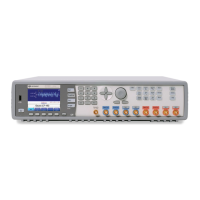Appendix
630
Non-Harmonic
Imperfections
The biggest source of non-harmonic spurious components (called “spurs”)
is the waveform DAC. Nonlinearity in the DAC leads to harmonics that are
aliased, or “folded back”, into the passband of the function generator. These
spurs are most significant when there is a simple fractional relationship
between the signal frequency and the function generator’s sampling
frequency (81150A: 2 GHz; 81160A: 2.5 GHz).
For example, at 225 MHz, the DAC produces harmonics at 450 MHz,
675 MHz, …, 1800 MHz, 2025 MHz. These harmonics, which are 200 MHz
and 25 MHz from the function generator’s 2 GHz sampling frequency, will
appear as spurs at 200 MHz and 25 MHz.
Another source of non-harmonic spurs is the coupling of unrelated signal
sources (such as the microprocessor clock) into the output signal. These
spurs usually have a constant amplitude ( 75 dBm or 112 Vpp)
regardless of the signal’s amplitude and are most troublesome at signal
amplitudes below 100 mVpp. To obtain low amplitudes with minimum
spurious content, keep the function generator’s output level relatively high
and use an external attenuator if possible.
Phase noise results from small, instantaneous changes in the output
frequency (“jitter”). It is seen as an elevation of the apparent noise floor
near the fundamental frequency and increases at 6 dBc / octave with the
carrier frequency. The 81150A / 81160A’s phase noise specification
represents the amplitude of the noise in a 1 Hz bandwidth, 10 kHz away
from the carrier.
Finite DAC resolution (14 bits) leads to voltage quantization errors.
Assuming the errors are uniformly distributed over a range of ±0.5 least-
significant bit (LSB), the equivalent noise level is -86 dBc for a sine wave
that uses the full DAC range (16,384 levels).
Similarly, finite-length waveform memory leads to phase quantization errors.
Treating these errors as low-level phase modulation and assuming a uniform
distribution over a range of ±0.5 LSB, the equivalent noise level is -76 dBc
for a sine wave that is 16K samples long. All of the 81150A / 81160A’s
standard waveforms use the entire DAC range and are 16K samples in
length. Any arbitrary waveforms that use less than the entire DAC range, or
that are specified with fewer than 16,384 points, will exhibit proportionally
higher relative quantization errors.

